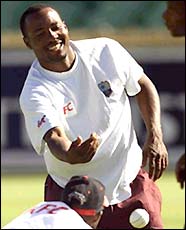Throughout the ages bowlers have seen themselves as downtrodden artisans compared to batsmen.
"The last bowler to be knighted," remarked wit, writer and leg spin bowler Arthur Mailey, "was Sir Francis Drake."
Mailey, a gifted if often profligate leg spin and googly bowler for Australia during the 1920s, would have winced in sympathy as 1,747 runs were accumulated in the recent fourth Test between Australia and India.
 Five batsmen in the all-time top 20 by average were present in Sydney for Steve Waugh's final Test. They included Australia's Matthew Hayden (58.28), Ricky Ponting (55.97) and Adam Gilchrist (55.59). India fielded Rahul Dravid (57.42), in 11th place one spot ahead of Sachin Tendulkar (57.19).
Five batsmen in the all-time top 20 by average were present in Sydney for Steve Waugh's final Test. They included Australia's Matthew Hayden (58.28), Ricky Ponting (55.97) and Adam Gilchrist (55.59). India fielded Rahul Dravid (57.42), in 11th place one spot ahead of Sachin Tendulkar (57.19).
Waugh retired with an average of 51.06 and more than 10,000 runs.
At the same time West Indies captain Brian Lara (52.69) was plundering runs off a South African team led by Graeme Smith (18th overall with 55.45).
Ruling out Smith, who has played only 20 Tests, six contemporary batsmen can present convincing cases for the title of world number one.
Statistics are one guide. Australian Don Bradman, who averaged 99.94 from 52 Tests, is a unanimous choice as the best batsman in the history of the game.
Context is another. Jamaican George Headley is one of a trio grouped behind Bradman with a Test average of over 60. Unlike Bradman, Headley batted in a struggling side, and on poor pitches his record was superior to the Australian's.
Then there is style. Steve Waugh started as a dasher, before ruthlessly refining his technique to eliminate error.
His reward was a Test average over 50, yet many supporters preferred to watch his twin brother Mark, more fallible but possessed of an insouciant ease and grace on the way to an average of just under 42.
LARA TOP
On a scale of one to 10, Hayden would not score highly for style. As a brutal slayer of opposing attacks he has no superior, displaying his strength and stamina to full effect in his world record 380 against Zimbabwe last year.
Ponting, Waugh's successor as Australia captain, is lightning fast on his feet and scored three double centuries in 2003 on the way to a calendar year average of more than 100.
Get past those two and the hapless bowlers encounter Adam Gilchrist, a gloriously clean striker of the ball. Of batsmen-wicketkeepers, only West Indian Clyde Walcott with 56.68 averages more and he did not always keep wicket.
Bradman famously thought Tendulkar was the batsman who most resembled him in style. After a lean run, the Indian eschewed the hook shot to compile his highest Test score of 241 not out in the fourth Test against Australia.
While Tendulkar struggled, the under-rated Dravid flourished. He set up India's upset second Test win with 233 then 72 not out followed by an unbeaten 91 for a series average of 123.80.
Statistics, context, style. Dravid qualifies as a great on all three counts.
By the same criteria, though, a conclusive case can be made for Lara, who currently tops the PriceWaterhouseCoopers world batting ratings.
Lara lost his world record to Hayden but in a struggling side his recent form has been breathtaking.
He struck a double century, century and two fifties against South Africa and took a world record 28 runs off one over from left- arm spinner Robin Peterson.
For style, the diminutive left-hander remains the most attractive of modern batsman, striking the ball with sumptuous timing after an extravagant backlift.
This year he has the chance to embellish his record with eight Tests against England. Lara averages 65.26 against the English, the opponents he struck to all parts of the field when scoring his then world record 375 in 1994.
Lara has survived a mid-career crisis during which he openly questioned his commitment to his sport. At the start of a new year he is deservedly world number one in a golden era for batsmen.








 © 2025
© 2025